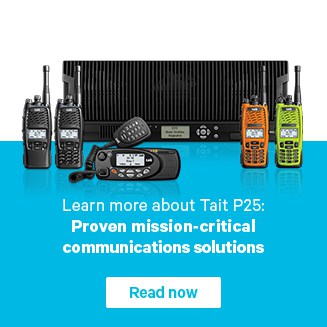Introduction to P25
Call Types and Features
P25 Voice Calls
In this topic, we will examine the typical voice call types on a P25 network.
Group Calls
A group call is a call from one person to a group of people and is typically the primary method of voice communication on a P25 trunked system.
The call starts when the PTT is pressed. A traffic channel is allocated for the call, and the first transmission is made. When the PTT is released, the channel may be released or it may be reserved for a few seconds for a reply from the same group.
Radios are programmed to use particular talk groups, and a group is selected just like selecting a conventional channel. Some systems support dynamic regrouping, where a system administrator can remotely place people into groups as operational needs arise.
Announcement Group
An announcement group is a predefined amalgamation of different talk groups into a single large group call. This allows important messages to get out to multiple teams on one transmission rather than having to be repeated multiple times.
The ability to use an announcement group is controlled by the system administrator.
System Call
There is also the ability to use a system call which enables coverage and reach to the broadest audience possible. When a system call is made, it will be received by all subscriber units and consoles registered on the system. An example of where a system call would be beneficial is an evacuation message for a work site in an emergency.
Emergency Calls
P25 also supports an emergency call. An emergency call provides users with the ability to inform dispatch personnel of a life threatening situation. By pressing the subscriber unit’s emergency alarm button, an alarm is sent to the dispatcher via the control channel. The dispatcher is immediately notified of the emergency status by an audible alert and visual display at the console. The unit making the emergency call will be assigned the highest priority level of voice channel access to the network.
A subscriber unit may be programmed so that pressing the PTT is still required to transmit voice calls in emergency mode, or the subscriber unit may be programmed to automatically cycle between receive and transmit, leaving the callers hands-free to deal with the emergency situation.
When the emergency voice call is transmitted, the receiving radios can also issue an audible alert beep so everyone listening knows that this is an emergency call.
Unit-to-Unit Calls
A unit-to-unit call allows a person to individually call another person or console and communicate privately. The unit ID of the person you’re calling must be entered into your radio before pressing the PTT to initiate this type of call. Typically, the receiving radio will show the calling party’s ID on the display and issue a ringing alert tone, so that they can then choose to take the call or not. Unit-to-unit calls are typically longer in duration than a single message to a talk group and, therefore, occupy radio channels for a longer period of time.
The ability to make unit-to-unit calls is under the control of the system administrator, and they may choose to limit who has access to this feature.
In addition to unit-to-unit calls, a P25 network can allow dialing a phone call from a radio unit. This can be valuable when working in areas where cell phone coverage is not available or hazardous locations prevent the use of cellular phones.
That was a quick overview of some of the different voice call types on a P25 radio system. One of the advantages of P25 is that voice calls can be encrypted with AES or DES encryption. This means they cannot be intercepted by a third party who does not have the encryption key.
 Radio Academy
Radio Academy





